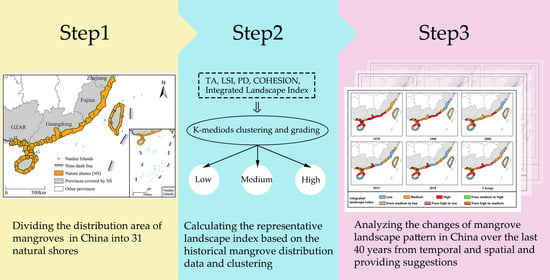Remote Sensing Based Spatial-Temporal Monitoring of the Changes in Coastline Mangrove Forests in China over the Last 40 Years
Abstract
1. Introduction
2. Materials and Methods
2.1. Study Area
2.2. Mangrove Distribution Data Based on Remote Sensing Interpretation
2.3. Selection and Calculation of the Landscape Index
2.4. Analysis of the Spatial and Temporal Changes in the Mangrove Landscape Pattern Based on the Landscape Indexes
2.5. Establishing and Analyzing the Integrated Landscape Index
3. Results
3.1. Spatial and Temporal Variation Analysis of Four Landscape Characteristics
3.1.1. Total Area
3.1.2. Shape Complexity
3.1.3. Fragmentation
3.1.4. Connectivity
3.2. Spatial and Temporal Variation Analysis of the Integrated Landscape State
4. Discussion
5. Conclusions
Author Contributions
Funding
Conflicts of Interest
Appendix A

References
- Zhang, K.Q.; Thapa, B.; Ross, M.; Gann, D. Remote sensing of seasonal changes and disturbances in mangrove forest: A case study from South Florida. Ecosphere 2016, 7. [Google Scholar] [CrossRef]
- Alongi, D.M. Present state and future of the world’s mangrove forests. Environ. Conserv. 2002, 29, 331–349. [Google Scholar] [CrossRef]
- Das, S.; Crepin, A.S. Mangroves can provide protection against wind damage during storms. Estuar. Coast. Shelf Sci. 2013, 134, 98–107. [Google Scholar] [CrossRef]
- Valiela, I.; Bowen, J.L.; York, J.K. Mangrove forests: One of the world’s threatened major tropical environments: At least 35% of the area of mangrove forests has been lost in the past two decades, losses that exceed those for tropical rain forests and coral reefs, two other well-known threatened environments. BioScience 2001, 51, 807–815. [Google Scholar]
- Hu, W.J.; Wang, Y.Y.; Zhang, D.; Yu, W.W.; Chen, G.C.; Xie, T.; Liu, Z.H.; Ma, Z.Y.; Du, J.G.; Chao, B.X.; et al. Mapping the potential of mangrove forest restoration based on species distribution models: A case study in China. Sci. Total Environ. 2020, 748. [Google Scholar] [CrossRef] [PubMed]
- Donato, D.C.; Kauffman, J.B.; Murdiyarso, D.; Kurnianto, S.; Stidham, M.; Kanninen, M. Mangroves among the most carbon-rich forests in the tropics. Nat. Geosci. 2011, 4, 293–297. [Google Scholar] [CrossRef]
- Hu, L.J.; Xu, N.; Liang, J.; Li, Z.C.; Chen, L.Z.; Zhao, F. Advancing the mapping of mangrove forests at national-scale using Sentinel-1 and Sentinel-2 time-series data with google earth engine: A case study in China. Remote Sens. 2020, 12, 3120. [Google Scholar] [CrossRef]
- Barbier, E.B. The protective service of mangrove ecosystems: A review of valuation methods. Mar. Pollut. Bull. 2016, 109, 676–681. [Google Scholar] [CrossRef]
- Spalding, M.D.; Ruffo, S.; Lacambra, C.; Meliane, I.; Hale, L.Z.; Shepard, C.C.; Beck, M.W. The role of ecosystems in coastal protection: Adapting to climate change and coastal hazards. Ocean Coast. Manag. 2014, 90, 50–57. [Google Scholar] [CrossRef]
- Alongi, D.M. Mangrove forests: Resilience, protection from tsunamis, and responses to global climate change. Estuar. Coast. Shelf Sci. 2008, 76, 1–13. [Google Scholar] [CrossRef]
- Zhao, C.P.; Qin, C.Z. 10-m-resolution mangrove maps of China derived from multi-source and multi-temporal satellite observations. ISPRS J. Photogramm. 2020, 169, 389–405. [Google Scholar] [CrossRef]
- Wang, L.; Jia, M.M.; Yin, D.M.; Tian, J.Y. A review of remote sensing for mangrove forests: 1956–2018. Remote Sens. Environ. 2019, 231. [Google Scholar] [CrossRef]
- Green, E.P.; Clark, C.D.; Mumby, P.J.; Edwards, A.J.; Ellis, A.C. Remote sensing techniques for mangrove mapping. Int. J. Remote Sens. 1998, 19, 935–956. [Google Scholar] [CrossRef]
- Xia, J.S.; Yokoya, N.; Pham, T.D. Probabilistic mangrove species mapping with multiple-source remote-sensing datasets using label distribution learning in Xuan Thuy National Park, Vietnam. Remote Sens. 2020, 12, 3834. [Google Scholar] [CrossRef]
- Chen, B.Q.; Xiao, X.M.; Li, X.P.; Pan, L.H.; Doughty, R.; Ma, J.; Dong, J.W.; Qin, Y.W.; Zhao, B.; Wu, Z.X.; et al. A mangrove forest map of China in 2015: Analysis of time series Landsat 7/8 and Sentinel-1A imagery in Google Earth Engine cloud computing platform. ISPRS J. Photogramm. 2017, 131, 104–120. [Google Scholar] [CrossRef]
- Conchedda, G.; Durieux, L.; Mayaux, P. An object-based method for mapping and change analysis in mangrove ecosystems. ISPRS J. Photogramm. 2008, 63, 578–589. [Google Scholar] [CrossRef]
- Giri, C.; Ochieng, E.; Tieszen, L.L.; Zhu, Z.; Singh, A.; Loveland, T.; Masek, J.; Duke, N. Status and distribution of mangrove forests of the world using earth observation satellite data. Glob. Ecol. Biogeogr. 2011, 20, 154–159. [Google Scholar] [CrossRef]
- Wang, D.Z.; Wan, B.; Qiu, P.H.; Su, Y.J.; Guo, Q.H.; Wang, R.; Sun, F.; Wu, X.C. Evaluating the performance of Sentinel-2, Landsat 8 and Pleiades-1 in mapping mangrove extent and species. Remote Sens. 2018, 10, 1468. [Google Scholar] [CrossRef]
- Lymburner, L.; Bunting, P.; Lucas, R.; Scarth, P.; Alam, I.; Phillips, C.; Ticehurst, C.; Held, A. Mapping the multi-decadal mangrove dynamics of the Australian coastline. Remote Sens. Environ. 2020, 238. [Google Scholar] [CrossRef]
- Seto, K.C.; Fragkias, M. Mangrove conversion and aquaculture development in Vietnam: A remote sensing-based approach for evaluating the Ramsar Convention on Wetlands. Glob. Environ. Chang. 2007, 17, 486–500. [Google Scholar] [CrossRef]
- Herbeck, L.S.; Krumme, U.; Andersen, T.J.; Jennerjahn, T.C. Decadal trends in mangrove and pond aquaculture cover on Hainan (China) since 1966: Mangrove loss, fragmentation and associated biogeochemical changes. Estuar. Coast. Shelf Sci. 2020, 233. [Google Scholar] [CrossRef]
- Bryan-Brown, D.N.; Connolly, R.; Richards, D.R.; Adame, F.; Friess, D.A.; Brown, C.J. Global trends in mangrove forest fragmentation. Sci. Rep. 2020, 10. [Google Scholar] [CrossRef] [PubMed]
- Bunting, P.; Rosenqvist, A.; Lucas, R.; Rebelo, L.M.; Hilarides, L.; Thomas, N.; Hardy, A.; Itoh, T.; Shimada, M.; Finlayson, C.M. The global mangrove watch–A new 2010 global baseline of mangrove extent. Remote Sens. 2018, 10, 1669. [Google Scholar] [CrossRef]
- Li, M.S.; Mao, L.J.; Shen, W.J.; Liu, S.Q.; Wei, A.S. Change and fragmentation trends of Zhanjiang mangrove forests in southern China using multi-temporal Landsat imagery (1977–2010). Estuar. Coast. Shelf Sci. 2013, 130, 111–120. [Google Scholar] [CrossRef]
- Wang, W.; Wang, M. China’s Mangrove; Science Press: Beijing, China, 2007. [Google Scholar]
- Wu, P.; Zhang, J.; Ma, Y.; Li, X. Remote sensing monitoring and analysis of the changes of mangrove resources in China in the past 20 years. Adv. Mar. Sci. 2013, 31, 406–414. [Google Scholar]
- Li, S.Z.; Xie, T.; Pennings, S.C.; Wang, Y.C.; Craft, C.; Hu, M.M. A comparison of coastal habitat restoration projects in China and the United States. Sci. Rep. 2019, 9. [Google Scholar] [CrossRef]
- Jia, M.M.; Wang, Z.M.; Zhang, Y.Z.; Mao, D.H.; Wang, C. Monitoring loss and recovery of mangrove forests during 42 years: The achievements of mangrove conservation in China. Int. J. Appl. Earth Obs. 2018, 73, 535–545. [Google Scholar] [CrossRef]
- Jia, M.M.; Wang, Z.M.; Zhang, Y.Z.; Ren, C.Y.; Song, K.S. Landsat-based estimation of mangrove forest loss and restoration in Guangxi Province, China, influenced by human and natural factors. IEEE J. Stars 2015, 8, 311–323. [Google Scholar] [CrossRef]
- Zhang, X.H. Decision tree algorithm of automatically extracting mangrove forests information from Landsat 8 OLI imagery. Remote Sens. Land. Res. 2016, 28, 182–187. [Google Scholar]
- Fan, H.; Wang, W. Some thematic issues for mangrove conservation in China. J. Xiamen Univ. Natl. Sci. 2017, 56, 323–330. [Google Scholar]
- Ma, C.L.; Ai, B.; Zhao, J.; Xu, X.P.; Huang, W. Change detection of mangrove forests in coastal Guangdong during the past three decades based on remote sensing data. Remote Sens. 2019, 11, 921. [Google Scholar] [CrossRef]
- Xin, K.; Huang, X.; Hu, J.L.; Li, C.; Yang, X.B.; Arndt, S.K. Land use change impacts on heavy metal sedimentation in mangrove wetlands-A case study in Dongzhai Harbor of Hainan, China. Wetlands 2014, 34, 1–8. [Google Scholar] [CrossRef]
- Huang, X.; Xin, K.; Li, X.; Wang, X.; Ren, L.; Li, X.; Yan, Z. Landscape pattern change of Dongzhai Harbour mangrove, South China analyzed with a patch-based method and its driving forces. Chin. J. Appl. Ecol. 2015, 26, 1510–1518. [Google Scholar]
- Yu, L.; Lin, S.; Jiao, X.; Shen, X.; Li, R. Ecological problems and protection countermeasures of mangrove wetland in Guangdong-Hong Kong-Macao Greater Bay Area. Acta Sci. Nat. Univ. Pekin. 2019, 55, 782–790. [Google Scholar]
- Qiu, N.; Xu, S.; Qiu, P.; Yang, W.; Yang, Q. Community distribution and landscape pattern of the mangrove on the Qi’ao Island, Zhuhai. Sci. Silvae Sinicae 2019, 55, 1–10. [Google Scholar]
- Li, T.; Zhao, Z.; Han, P. Detection and analysis of mangrove changes with multi-temporal remotely sensed imagery in the Shenzhen River Estuary. J. Remote Sens. 2002, 6, 364–369. [Google Scholar]
- Fang, J. Analysis and Optimization of Green Space Landscape Pattern in Lankao County Based on GIS and FRAGSTATS. Ph.D. Thesis, Zhengzhou University, Zhengzhou, China, 2018. [Google Scholar]
- Sasmito, S.D.; Taillardat, P.; Clendenning, J.N.; Cameron, C.; Friess, D.A.; Murdiyarso, D.; Hutley, L.B. Effect of land-use and land-cover change on mangrove blue carbon: A systematic review. Glob. Chang. Biol. 2019, 25, 4291–4302. [Google Scholar] [CrossRef]
- Chen, L.Z.; Wang, W.Q.; Zhang, Y.H.; Lin, G.H. Recent progresses in mangrove conservation, restoration and research in China. J. Plant Ecol. 2009, 2, 45–54. [Google Scholar] [CrossRef]
- Land Satellite Remote Sensing Application Center, Ministry of Natural Resources. Remote Sensing Monitoring of Mangrove Resources in China (1978–2018); Geological Publishing House: Beijing, China, 2019. [Google Scholar]
- Zhang, T.; Hu, S.; He, Y.; You, S.; Yang, X.; Gan, Y.; Liu, A. A fine-scale mangrove map of china derived from 2-meter resolution satellite observations and field data. ISPRS Int. J. Geo. Inf. 2021, 10, 92. [Google Scholar] [CrossRef]
- Barau, A.S.; Qureshi, S. Using agent-based modelling and landscape metrics to assess landscape fragmentation in Iskandar Malaysia. Ecol. Proc. 2015, 4, 8. [Google Scholar] [CrossRef]
- Drew, C.A.; Eggleston, D.B. Juvenile fish densities in Florida Keys mangroves correlate with landscape characteristics. Mar. Ecol. Prog. Ser. 2008, 362, 233–243. [Google Scholar] [CrossRef][Green Version]
- Sadro, S.; Nelson, C.E.; Melack, J.M. The Influence of landscape position and catchment characteristics on aquatic biogeochemistry in high-elevation lake-chains. Ecosystems 2012, 15, 363–386. [Google Scholar] [CrossRef]
- Pace, M.; Borg, J.A.; Galdies, C.; Malhotra, A. Influence of wave climate on architecture and landscape characteristics of Posidonia oceanica meadows. Mar. Ecol. Evol. Persp. 2017, 38. [Google Scholar] [CrossRef]
- Krummel, J.R.; Gardner, R.H.; Sugihara, G.; Oneill, R.V.; Coleman, P.R. Landscape patterns in a disturbed environment. Oikos 1987, 48, 321–324. [Google Scholar] [CrossRef]
- O’Neill, R.V.; Krummel, J.R.; Gardner, R.H.; Sugihara, G.; Jackson, B.; DeAngelis, D.L.; Milne, B.T.; Turner, M.G.; Zygmunt, B.; Christensen, S.W.; et al. Indices of landscape pattern. Landsc. Ecol. 1988, 1, 153–162. [Google Scholar] [CrossRef]
- Manson, F.J.; Loneragan, N.R.; Phinn, S.R. Spatial and temporal variation in distribution of mangroves in Moreton Bay, subtropical Australia: A comparison of pattern metrics and change detection analyses based on aerial photographs. Estuar. Coast. Shelf Sci. 2003, 57, 653–666. [Google Scholar] [CrossRef]
- Plexida, S.G.; Sfougaris, A.I.; Ispikoudis, I.P.; Papanastasis, V.P. Selecting landscape metrics as indicators of spatial heterogeneity-A comparison among Greek landscapes. Int. J. Appl. Earth Obs. 2014, 26, 26–35. [Google Scholar] [CrossRef]
- De Winter, J.C.F.; Gosling, S.D.; Potter, J. Comparing the pearson and spearman correlation coefficients across distributions and sample sizes: A tutorial using simulations and empirical data. Psychol. Methods 2016, 21, 273–290. [Google Scholar] [CrossRef]
- McGarigal, K. FRAGSTATS Help; University of Massachusetts: Amherst, MA, USA, 2015; p. 182. [Google Scholar]
- Park, H.S.; Jun, C.H. A simple and fast algorithm for K-medoids clustering. Expert Syst. Appl. 2009, 36, 3336–3341. [Google Scholar] [CrossRef]
- Mendenhall, W.M.; Sincich, T.L. Statistics for Engineering and the Sciences; CRC Press: Boca Raton, FL, USA, 2016. [Google Scholar]
- Rousseeuw, P.J. Silhouettes: A graphical aid to the interpretation and validation of cluster analysis. J. Comput. Appl. Math. 1987, 20, 53–65. [Google Scholar] [CrossRef]
- Leempoel, K.; Satyaranayana, B.; Bourgeois, C.; Zhang, J.; Chen, M.; Wang, J.; Bogaert, J.; Dahdouh-Guebas, F. Dynamics in mangroves assessed by high-resolution and multi-temporal satellite data: A case study in Zhanjiang Mangrove National Nature Reserve (ZMNNR), P.R. China. Biogeosciences 2013, 10, 5681–5689. [Google Scholar] [CrossRef]
- Zhang, W.; Zhang, Y.; Zhang, H.; Chao, W.; Yang, L.; Jia, D.; Sun, R. Mangrove and the construction of regional ecological security pattern in Zhanjiang. Geogr. Res. 2010, 29, 607–616. [Google Scholar] [CrossRef]
- Regulations of Guangdong Province on Wetland Protection. Available online: http://www.zjhsl.org/html/quwugongkai/zhengcefagui/2013/1016/55.html (accessed on 16 May 2021).
- Regulations of the People’s Republic of China on Nature Reserves. Available online: http://www.zjhsl.org/html/quwugongkai/zhengcefagui/2013/1016/54.html (accessed on 16 May 2021).
- Peng, L. A review on the mangrove research in China. J. Xiamen Univ. Nat. Sci. 2001, 2, 592–603. [Google Scholar]
- Zhang, Q.; Sui, S. The mangrove wetland resources and their conservation in China. J. Nat. Resour. 2001, 16, 28–36. [Google Scholar]
- Samson, M.S.; Rollon, R.N. Growth performance of planted mangroves in the Philippines: Revisiting forest management strategies. Ambio 2008, 37, 234–240. [Google Scholar] [CrossRef]
- Matsui, N.; Songsangjinda, P.; Morimune, K. Mangrove rehabilitation on highly eroded coastal shorelines at Samut Sakhon, Thailand. Int. J. Ecol. 2012, 2012, 1–11. [Google Scholar]
- Duke, N.C. Mangrove reforestation in Panama: An evaluation of planting in areas deforested by a large oil spill. In Restoration of Mangrove Ecosystems; Field, C.D., Ed.; International Tropical Timber Organization, and International Society for Mangrove Ecosystems: Okinawa, Japan, 1996; pp. 209–232. [Google Scholar]
- Schmitt, K.; Duke, N.C. Mangrove Management, Assessment and Monitoring. Tropical Forestry Handbook; Michael, K., Laslo, P., Eds.; Springer: Berlin/Heidelberg, Germany, 2015; pp. 1–29. [Google Scholar]
- State Forestry Administration. Report of Mangroves Survey in China. 2002. Available online: http://www.forestry.gov.cn/ (accessed on 16 May 2021).
- Schmitt, K.; Albers, T.; Pham, T.T.; Dinh, S.C. Site-specific and integrated adaptation to climate change in the coastal mangrove zone of Soc Trang Province, Viet Nam. J. Coast. Conserv. 2013, 17, 545–558. [Google Scholar] [CrossRef]
- Lewis, R.R.; Brown, B. Ecological Mangrove Rehabilitation—A Field Manual for Practitioners. Mangrove Action Project, Canadian International Development Agency and OXFAM. 2014. Available online: https://blue-forests.org/wp-content/uploads/2020/04/Whole-EMR-Manual-English.pdf (accessed on 16 May 2021).
- Dahdouh-Guebas, F. World atlas of mangroves. Hum. Ecol. 2011, 39, 107–109. [Google Scholar] [CrossRef]
- Souza, P.W.M.; Martins, E.D.; da Costa, F.R. Using mangroves as a geological indicator of coastal changes in the Braganca macrotidal flat, Brazilian Amazon: A remote sensing data approach. Ocean Coast. Manag. 2006, 49, 462–475. [Google Scholar] [CrossRef]
- Long, J.B.; Giri, C. Mapping the Philippines’ mangrove forests using Landsat imagery. Sensors 2011, 11, 2972–2981. [Google Scholar] [CrossRef]
- Thomas, N.; Lucas, R.; Bunting, P.; Hardy, A.; Rosenqvist, A.; Simard, M. Distribution and drivers of global mangrove forest change, 1996–2010. PLoS ONE 2017, 12, e0179302. [Google Scholar] [CrossRef] [PubMed]
- Phonphan, W.; Thanakunwutthirot, M. Mapping of mangrove change with remote sensing in Samut Songkhram Province, Thailand. In International Conference on Human Interaction and Emerging Technologies; Ahram, T., Taiar, R., Gremeaux-Bader, V., Aminian, K., Eds.; Springer: Cham, Switzerland, 2020; pp. 191–197. [Google Scholar]
- Vaz, E. Managing urban coastal areas through landscape metrics: An assessment of Mumbai’s mangrove system. Ocean Coast. Manag. 2014, 98, 27–37. [Google Scholar] [CrossRef]
- Millan-Aguilar, O.; Nettel-Hernanz, A.; Hurtado-Oliva, M.A.; Dodd, R.S.; Flores-Cardenas, F.; Manzano-Sarabia, M. Landscape metrics and conservation status of five mangrove wetlands in the eastern gulf of California margin. J. Coast. Res. 2020, 36, 94–102. [Google Scholar] [CrossRef]
- Seto, K.C.; Fragkias, M. Quantifying spatiotemporal patterns of urban land-use change in four cities of China with time series landscape metrics. Landsc. Ecol. 2005, 20, 871–888. [Google Scholar] [CrossRef]
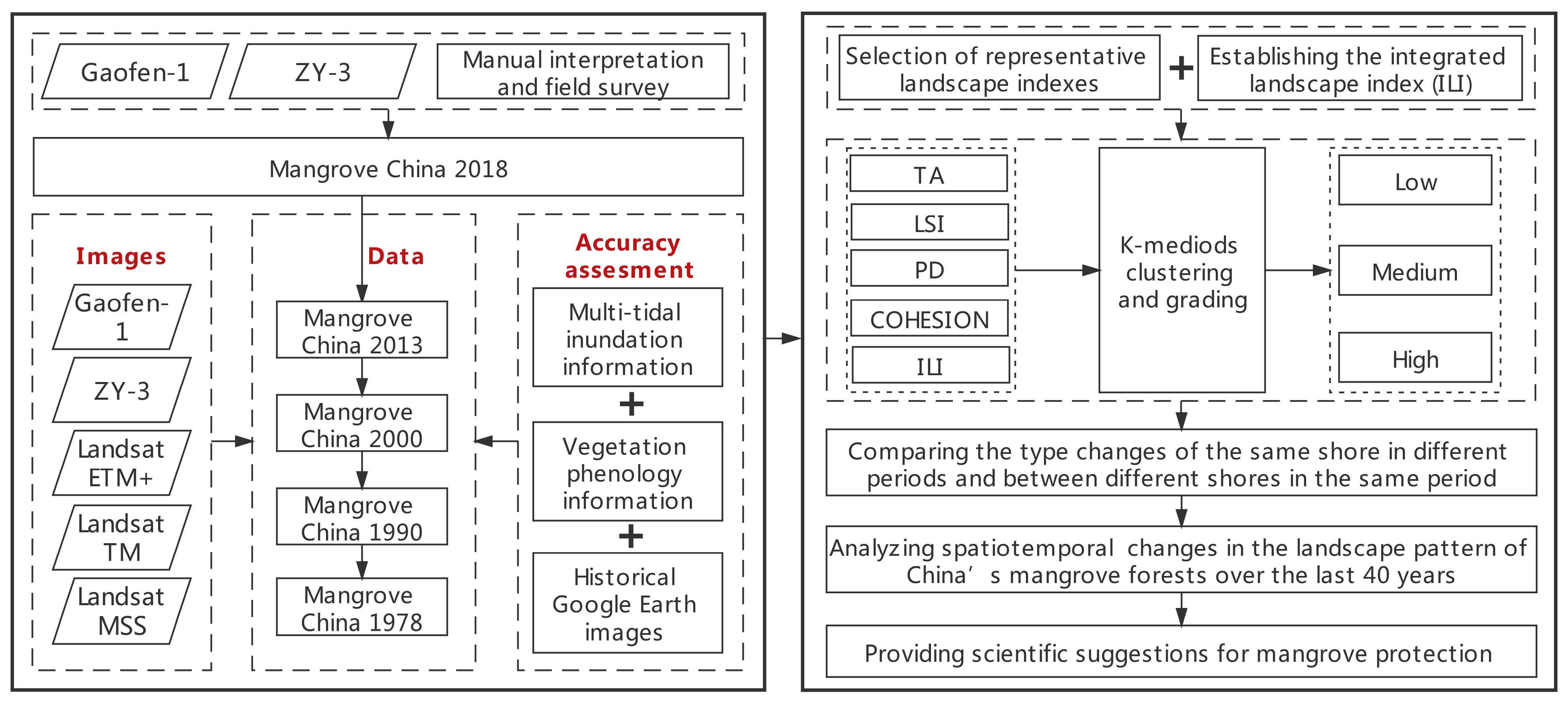

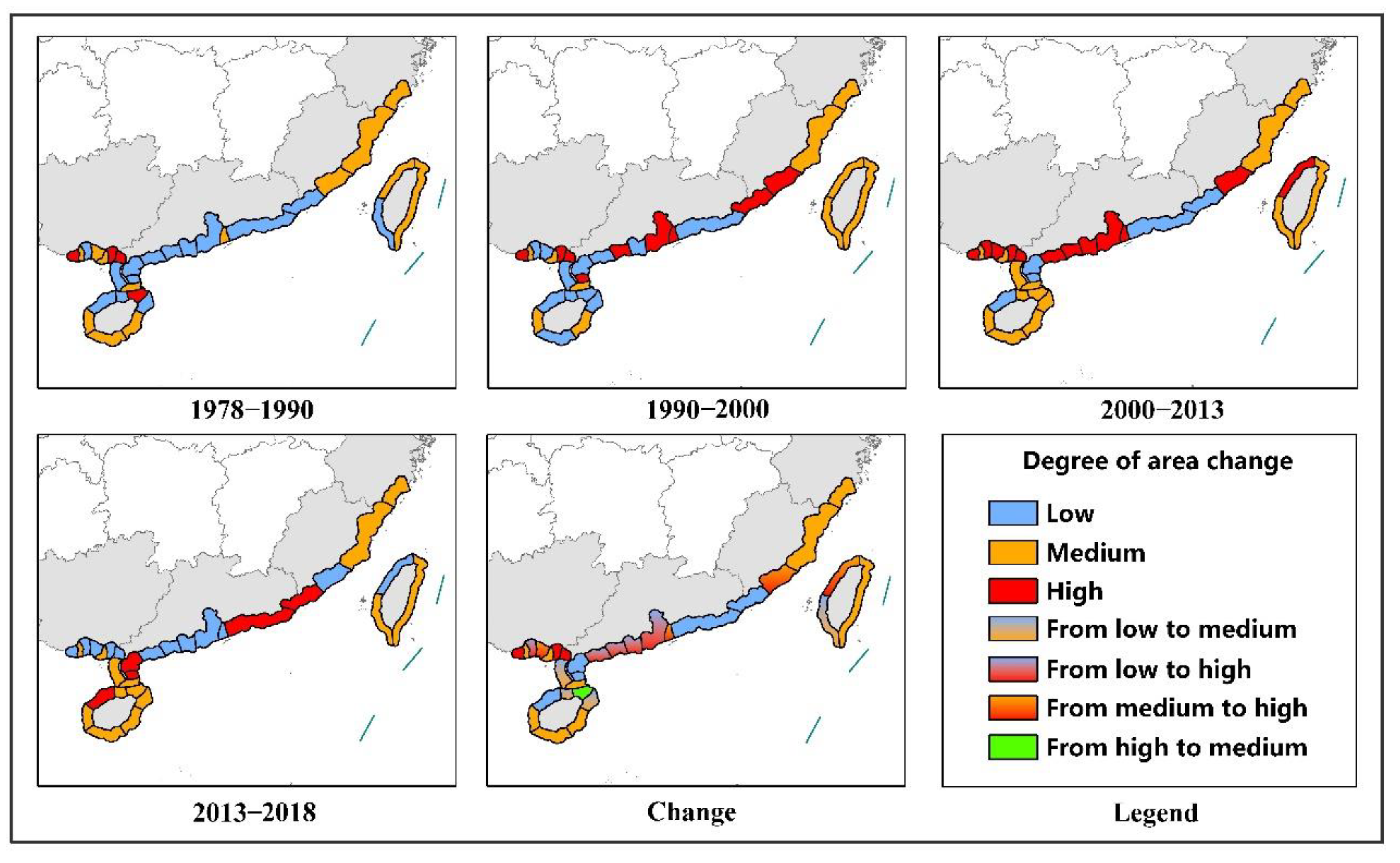
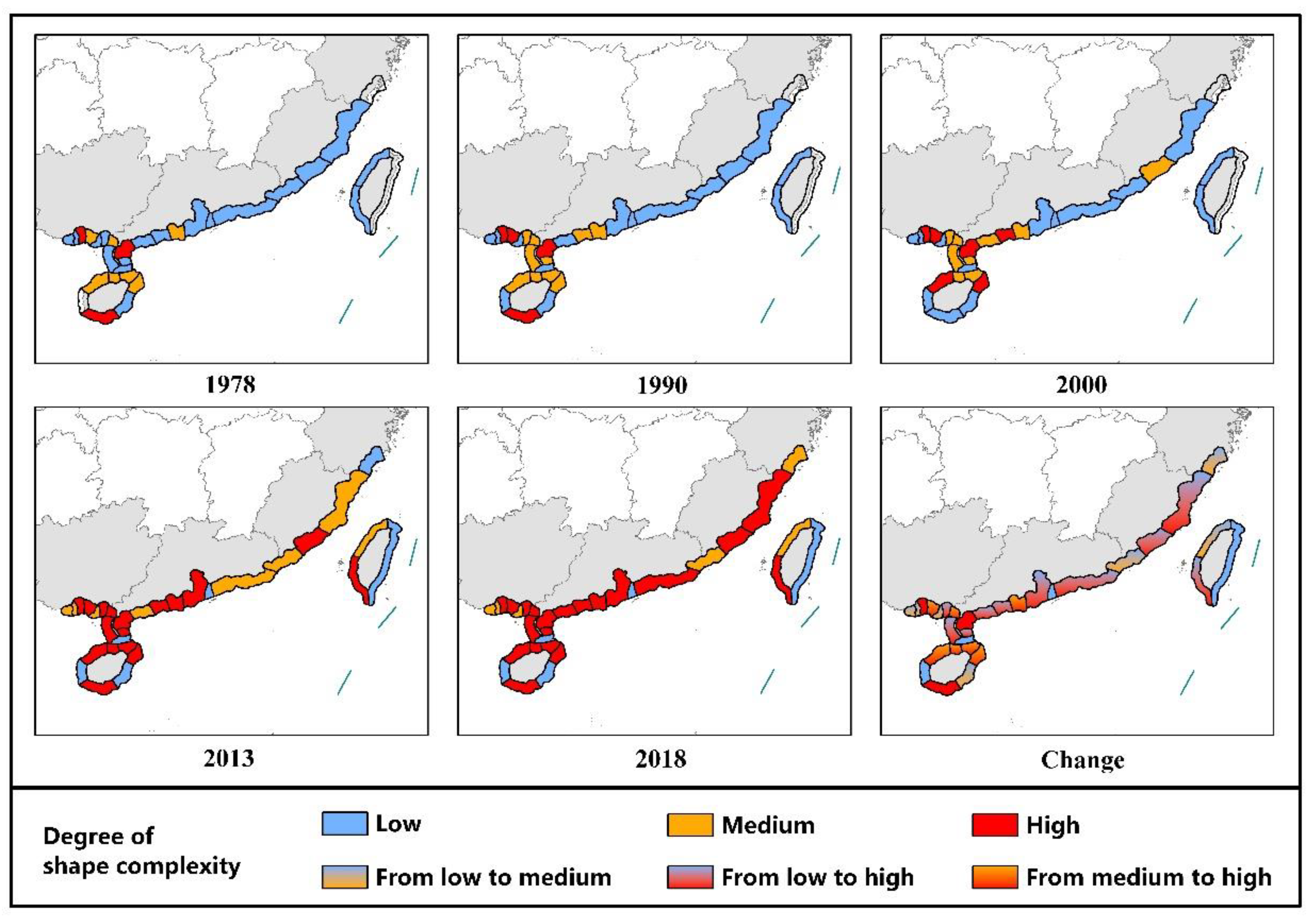
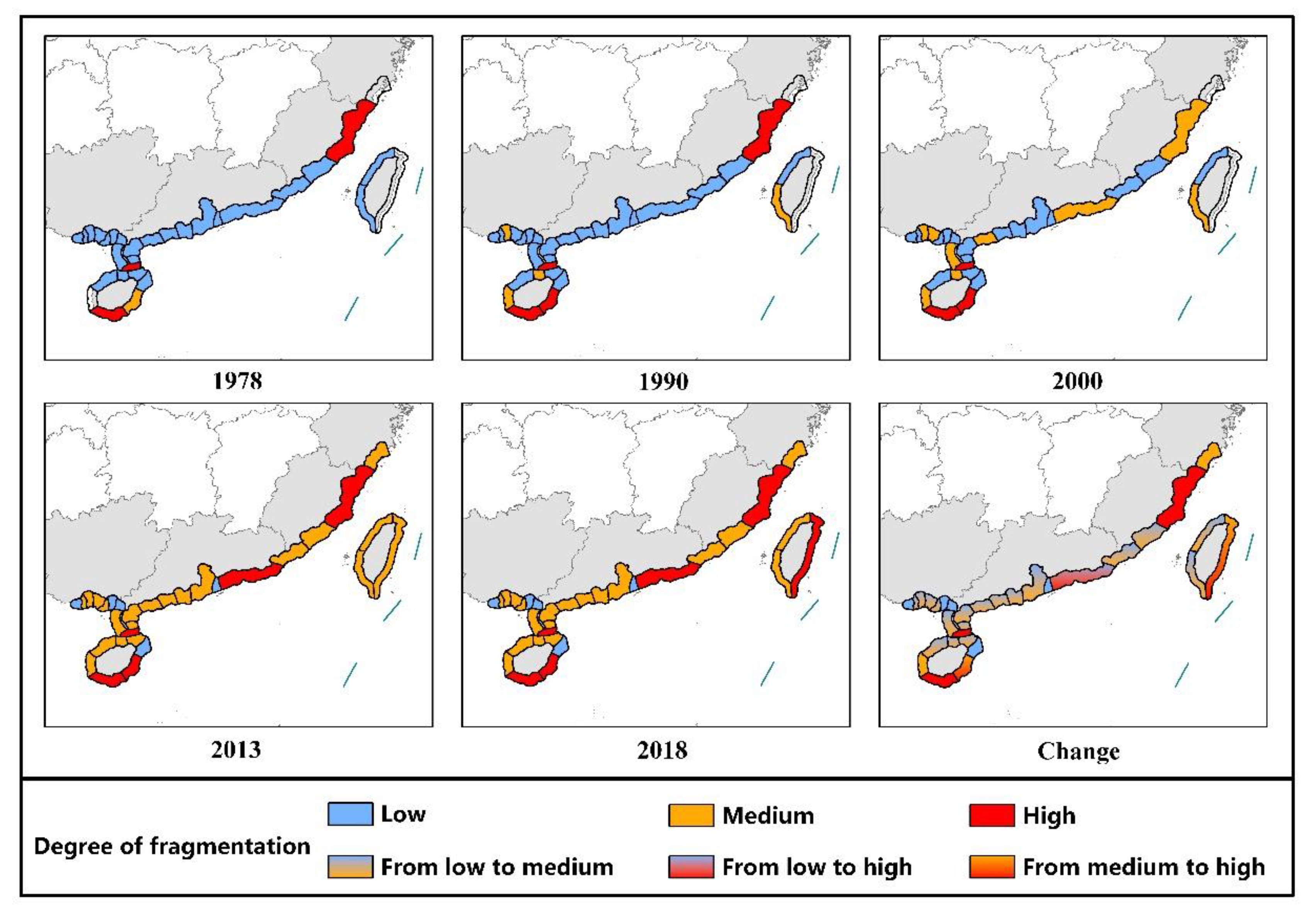

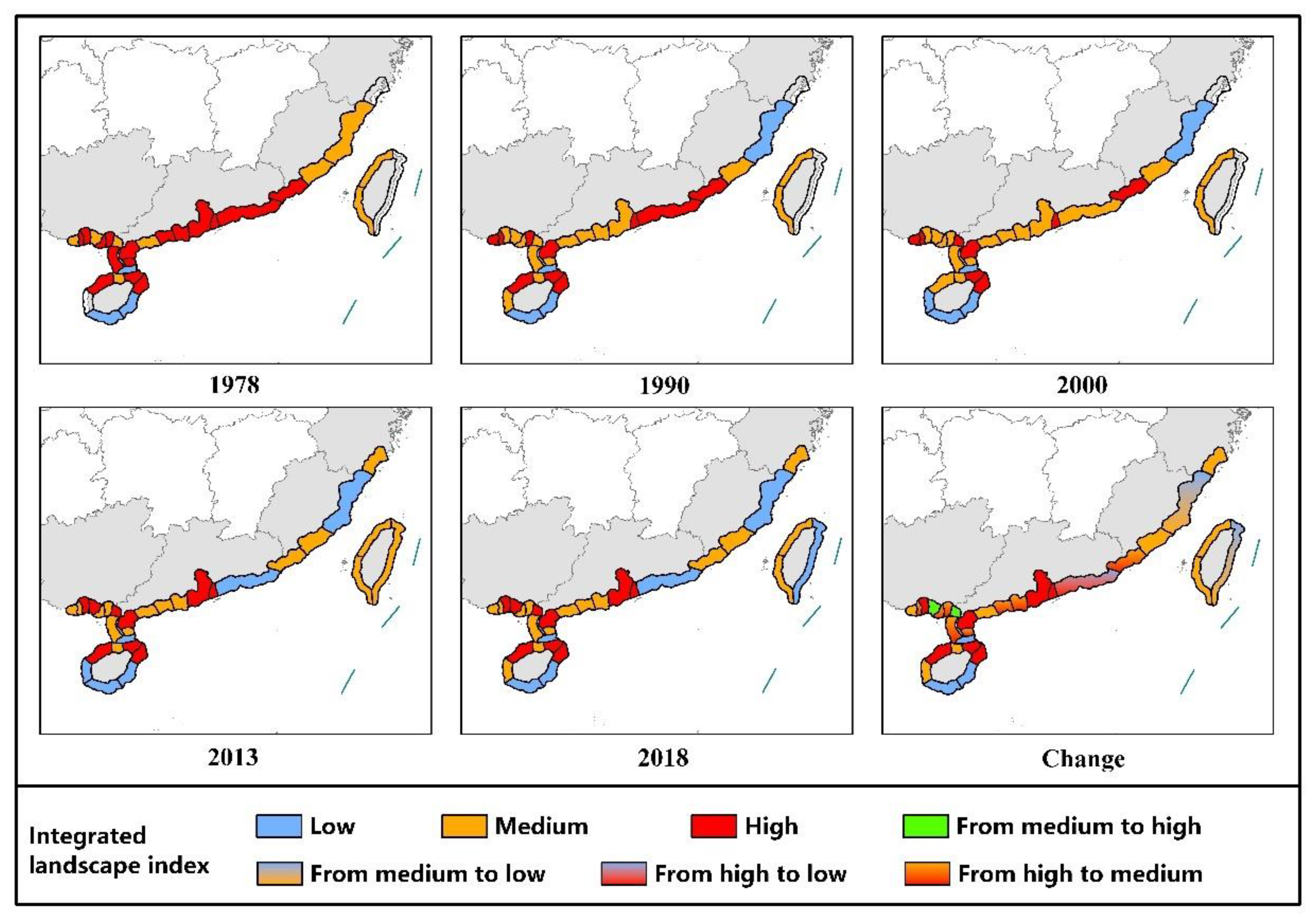
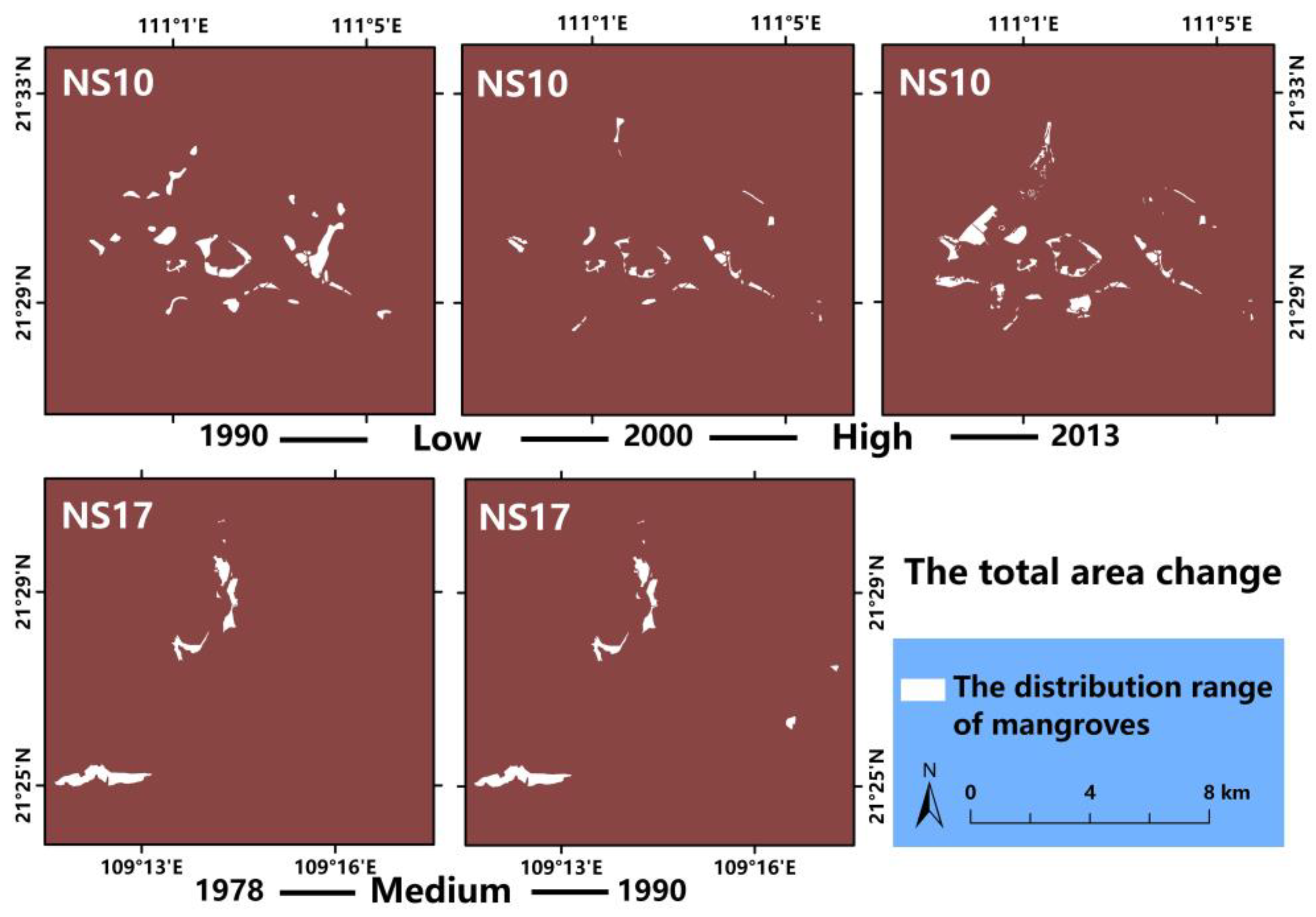
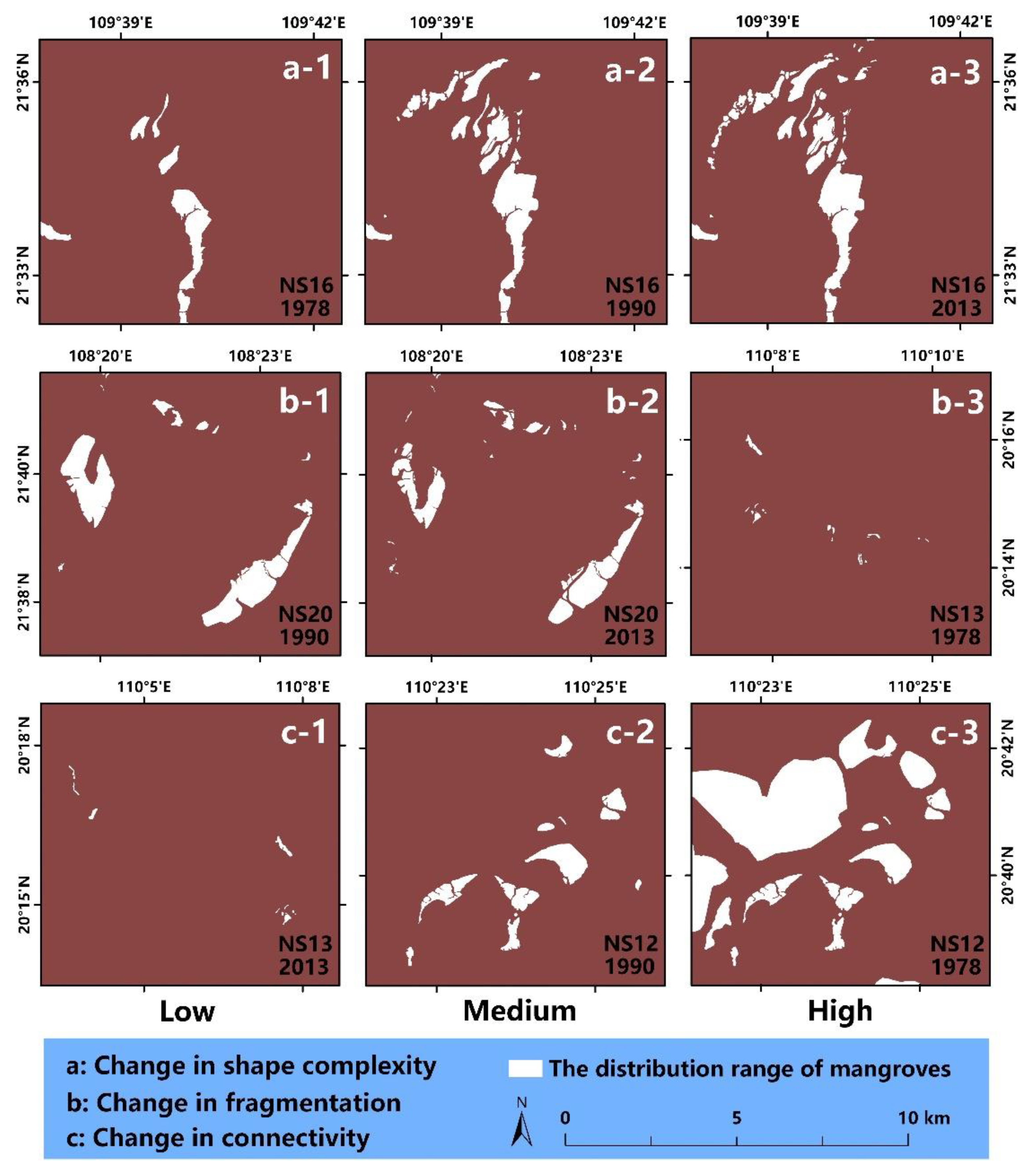

| Province | Number | Name |
|---|---|---|
| Zhejiang | 1 | Taizhou–Wenzhou Shore |
| Fujian | 2 | Ningde–Fuzhou–Putian Shore |
| 3 | Quanzhou–Xiamen Shore | |
| 4 | Yunxiao–Shantou Shore | |
| Guangdong (for the convenience of statistics, the shores located in Hong Kong and the Macao Special Administrative Region were listed in Guangdong) | 5 | Shantou–Hong Kong Shore |
| 6 | Shenzhen Bay Shore | |
| 7 | The Pearl River Estuary Shore | |
| 8 | Taishan–Enping Shore | |
| 9 | Yangjiang Shore | |
| 10 | Maoming Shore | |
| 11 | Zhanjiang Port–Leizhou Bay Shore | |
| 12 | Zhanjiang–Xinliao Shore | |
| 13 | Zhanjiang–South Xuwen Shore | |
| 14 | Zhanjiang–West Leizhou Shore | |
| 15 | Zhanjiang–Anpu Shore | |
| Guangxi Zhuang Autonomous Region (GZAR) | 16 | Shankou–Tieshan Port Shore |
| 17 | Beihai Shore | |
| 18 | Hepu–Dafengjiangkou Shore | |
| 19 | Qinzhou Bay Shore | |
| 20 | Fangcheng Port Shore | |
| 21 | Beilunhekou Shore | |
| Hainan | 22 | Haikou–Dongzhai Port Shore |
| 23 | Haiou–Lingaojiao Shore | |
| 24 | Lingaojiao–Danzhou Shore | |
| 25 | Dongfang Shore | |
| 26 | Yinggehai–Sanya Shore | |
| 27 | Wanning–Qionghai Shore | |
| 28 | Hainan–Wenchang Shore | |
| Taiwan | 29 | Taipei–Taichung Shore |
| 30 | Tainan–Gaoxiong Shore | |
| 31 | Taitung Shore |
| Year | Satellite | Sensor | Resolution |
|---|---|---|---|
| 2013 | Gaofen-1 | PMS | 2 m |
| ZY-3 | NAD and MUX | 2 m | |
| 2000 | Landsat7 | ETM+ | 15 m |
| 1990 | Landsat5 | TM | 30 m |
| 1978 | Landsat1,2 and 3 | MSS | 60 m |
| Index | Formula | Units | Range | Ecological Significance |
|---|---|---|---|---|
| TA | : the total landscape area (m2) | ha | TA was used to define the magnitude of the landscape. In landscape ecological construction, the area of the landscape is the most important factor used to maintain the stability of the ecosystem. | |
| PD | : Total number of patches in landscape | number (100 ha) | PD represents the patch fragmentation of the landscape. The higher the patch density, the greater the degree of landscape fragmentation. In addition, a higher patch density indicates that the landscape ecological process is active. | |
| LSI | : The total length of the edge in the landscape | / | The shape complexity is measured by calculating the deviation between the patch shape and a circle or square with the same area. It can also indicate the intensity of human intervention. The larger the LSI, the more complex the shape, and the smaller the intensity of the manual intervention. | |
| COHESION | : Perimeter of patch expressed as cell number; : Area of patch expressed as cell number; : Total number of cells in the landscape | / | 0 < < 100 | COHESION can be used to measure the physical connectivity between patches and to characterize the habitat connectivity between patches. The higher the value, the better the connectivity between the patches. |
| TA | LSI | PD | COHESION | |
|---|---|---|---|---|
| TA | 1.000 | 0.595 ** | −0.550 ** | 0.389 ** |
| LSI | 1.000 | 0.191 * | −0.341 ** | |
| PD | 1.000 | −0.659 ** | ||
| COHESION | 1.000 |
| Level | Mean Value of Total Area | Number of Shores Included in Each Period | |||
|---|---|---|---|---|---|
| 1978–1990 | 1990–2000 | 2000–2013 | 2013–2018 | ||
| Decrease (low) | −415.991 | 14 | 12 | 5 | 5 |
| Slight increase (medium) | 32.903 | 13 | 10 | 14 | 14 |
| Significant increase (high) | 299.058 | 4 | 9 | 12 | 12 |
| Level | Mean Value of LSI | Number of Shores Included in Each Period | ||||
|---|---|---|---|---|---|---|
| 1978 | 1990 | 2000 | 2013 | 2018 | ||
| Low | 7.595 | 18 | 16 | 13 | 6 | 4 |
| Medium | 14.238 | 7 | 10 | 9 | 8 | 7 |
| High | 23.699 | 3 | 4 | 7 | 17 | 20 |
| Level | Mean Value of PD | Number of Shores Included in Each Period | ||||
|---|---|---|---|---|---|---|
| 1978 | 1990 | 2000 | 2013 | 2018 | ||
| Low | 8.914 | 24 | 22 | 17 | 5 | 5 |
| Medium | 28.838 | 1 | 4 | 9 | 21 | 20 |
| High | 103.1019 | 3 | 3 | 3 | 5 | 6 |
| Level | Mean Value of COHESION | Number of Shores Included in Each Period | ||||
|---|---|---|---|---|---|---|
| 1978 | 1990 | 2000 | 2013 | 2018 | ||
| Low | 94.507 | 1 | 2 | 2 | 5 | 6 |
| Medium | 97.539 | 7 | 13 | 20 | 22 | 22 |
| High | 98.972 | 20 | 14 | 7 | 4 | 3 |
| Level | Mean Value of ILI | Number of Shores Included in Each Period | ||||
|---|---|---|---|---|---|---|
| 1978 | 1990 | 2000 | 2013 | 2018 | ||
| Low | −0.098 | 3 | 4 | 5 | 6 | 6 |
| Medium | 1.848 | 9 | 15 | 16 | 16 | 17 |
| High | 2.969 | 16 | 10 | 8 | 9 | 8 |
| Landscape Characteristic | Spatial-Temporal Variation Characteristics | Individual Case (the Shore Numbers) | ||
|---|---|---|---|---|
| Temporal | Spatial | Always Low | Always High | |
| Total area change | The area decreased from 1978 to 2000. After 2000, the area decreases gradually ceased and changed into increases. | The decrease in the area mainly occurred in Guangdong Province and northern Hainan Province. | 4, 5, 11, 12, 24 | 15, 16, 21 |
| Shape complexity | From 1978 to 2000, the shape complexity of most of the shores was relatively simple, that is, they were significantly affected by artificial interferences. After 2000, the shape complexity gradually increased, which means that the degree of artificial interference gradually weakened. | The initial change (increase) in the shape complexity was concentrated in southwestern Guangdong Province and northern Hainan Province, and then, it extended to most of the shores. | 6, 13, 25, 27, 31 | 11, 19, 26 |
| Fragmentation | From 1978 to 2000, most of the shores had a low degree of fragmentation. After 2000, the degree of fragmentation gradually increased. | Most of the shores exhibited continuous deterioration. The deterioration initially occurred in Fujian Province and northeastern and southwestern Guangdong Province, and then, it gradually extended to most of the shores. | 2, 13, 26 | 6, 15, 16, 21, 28 |
| Connectivity | In 1978–2000, the overall connectivity continued to deteriorate. In 2000–2018, the deterioration of the connectivity was curbed, and some of the shores even improved. | The deterioration of the connectivity initially occurred in Fujian Province and southwestern Guangdong, and then, it extended to most of the shores. The shores in Fujian, northeastern Guangdong, and southern Hainan continued to deteriorate. | 26, 27 | 6, 22, 28 |
| Integrated landscape state | In 1978–2000, the overall integrated landscape state continued to deteriorate. In 2000–2018, the deterioration of most of the shores was controlled. | The deterioration of the integrated landscape state initially occurred in southwestern Guangdong and the GZAR, and then, it gradually extended to most of the shores. The shores in Fujian, eastern Guangdong, and eastern Taiwan have been continuously deteriorating over the last 40 years. | 13, 26, 27 | 6, 7, 11, 19, 24, 27, 28 |
Publisher’s Note: MDPI stays neutral with regard to jurisdictional claims in published maps and institutional affiliations. |
© 2021 by the authors. Licensee MDPI, Basel, Switzerland. This article is an open access article distributed under the terms and conditions of the Creative Commons Attribution (CC BY) license (https://creativecommons.org/licenses/by/4.0/).
Share and Cite
Zhang, J.; Yang, X.; Wang, Z.; Zhang, T.; Liu, X. Remote Sensing Based Spatial-Temporal Monitoring of the Changes in Coastline Mangrove Forests in China over the Last 40 Years. Remote Sens. 2021, 13, 1986. https://doi.org/10.3390/rs13101986
Zhang J, Yang X, Wang Z, Zhang T, Liu X. Remote Sensing Based Spatial-Temporal Monitoring of the Changes in Coastline Mangrove Forests in China over the Last 40 Years. Remote Sensing. 2021; 13(10):1986. https://doi.org/10.3390/rs13101986
Chicago/Turabian StyleZhang, Junyao, Xiaomei Yang, Zhihua Wang, Tao Zhang, and Xiaoliang Liu. 2021. "Remote Sensing Based Spatial-Temporal Monitoring of the Changes in Coastline Mangrove Forests in China over the Last 40 Years" Remote Sensing 13, no. 10: 1986. https://doi.org/10.3390/rs13101986
APA StyleZhang, J., Yang, X., Wang, Z., Zhang, T., & Liu, X. (2021). Remote Sensing Based Spatial-Temporal Monitoring of the Changes in Coastline Mangrove Forests in China over the Last 40 Years. Remote Sensing, 13(10), 1986. https://doi.org/10.3390/rs13101986







